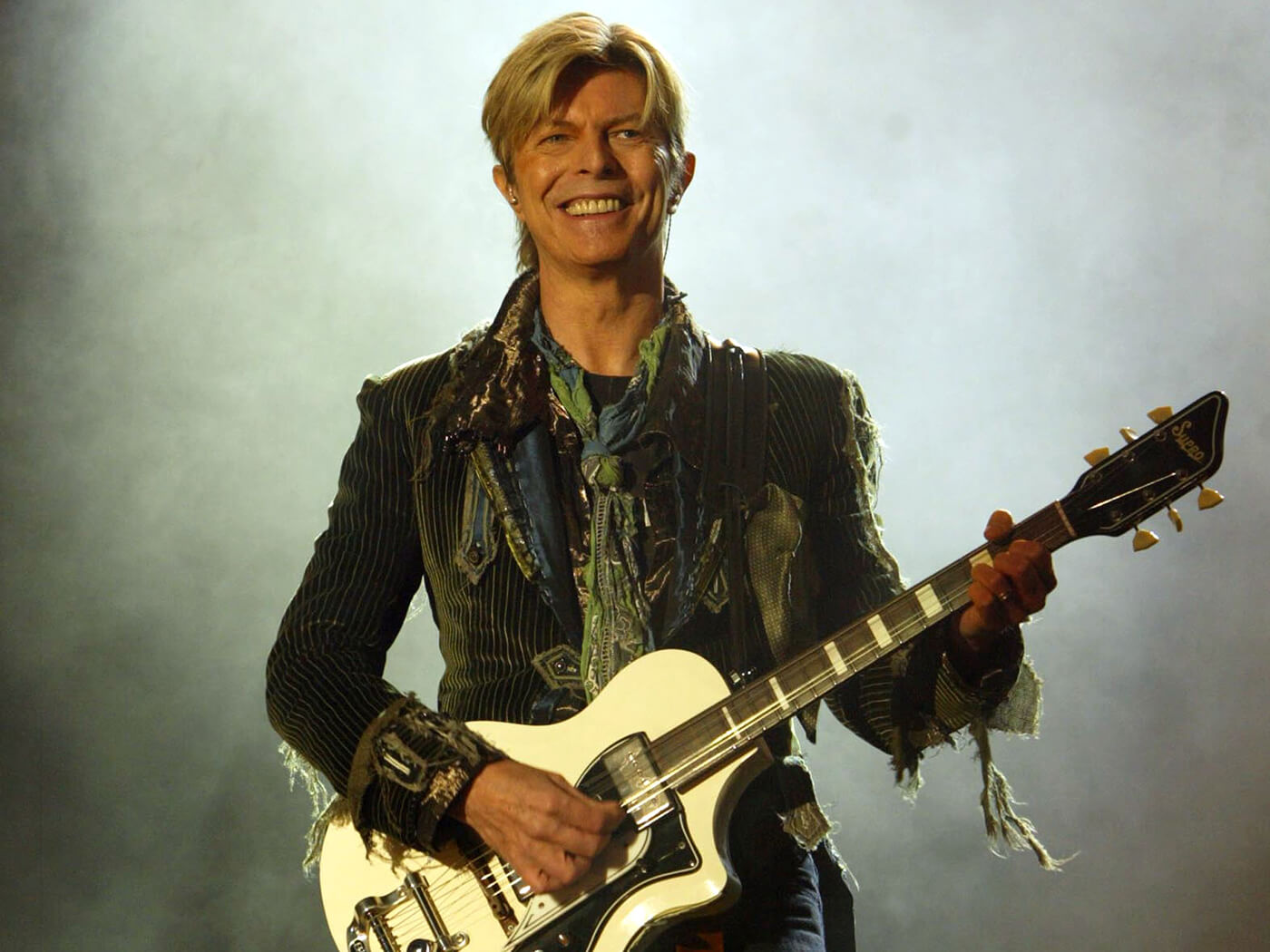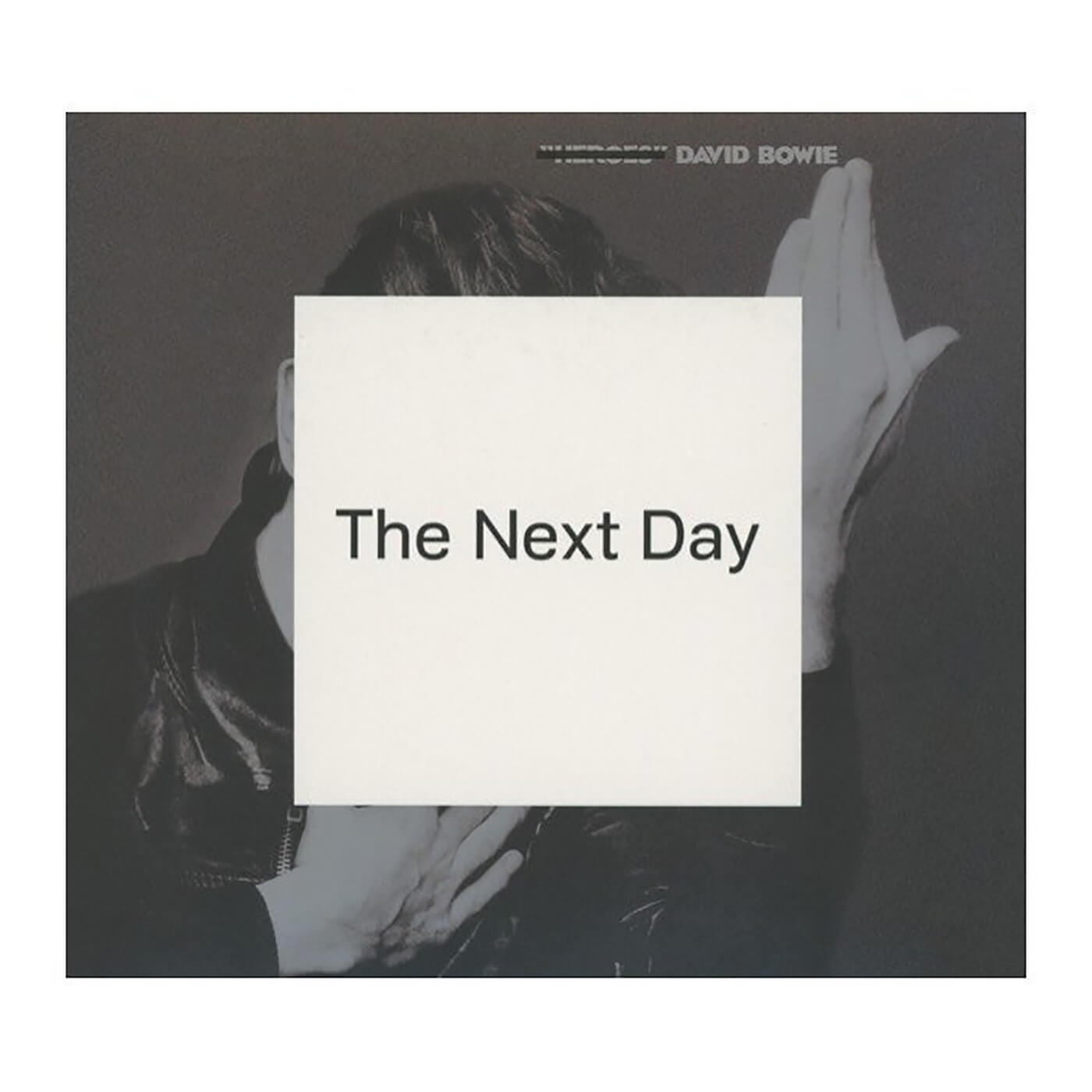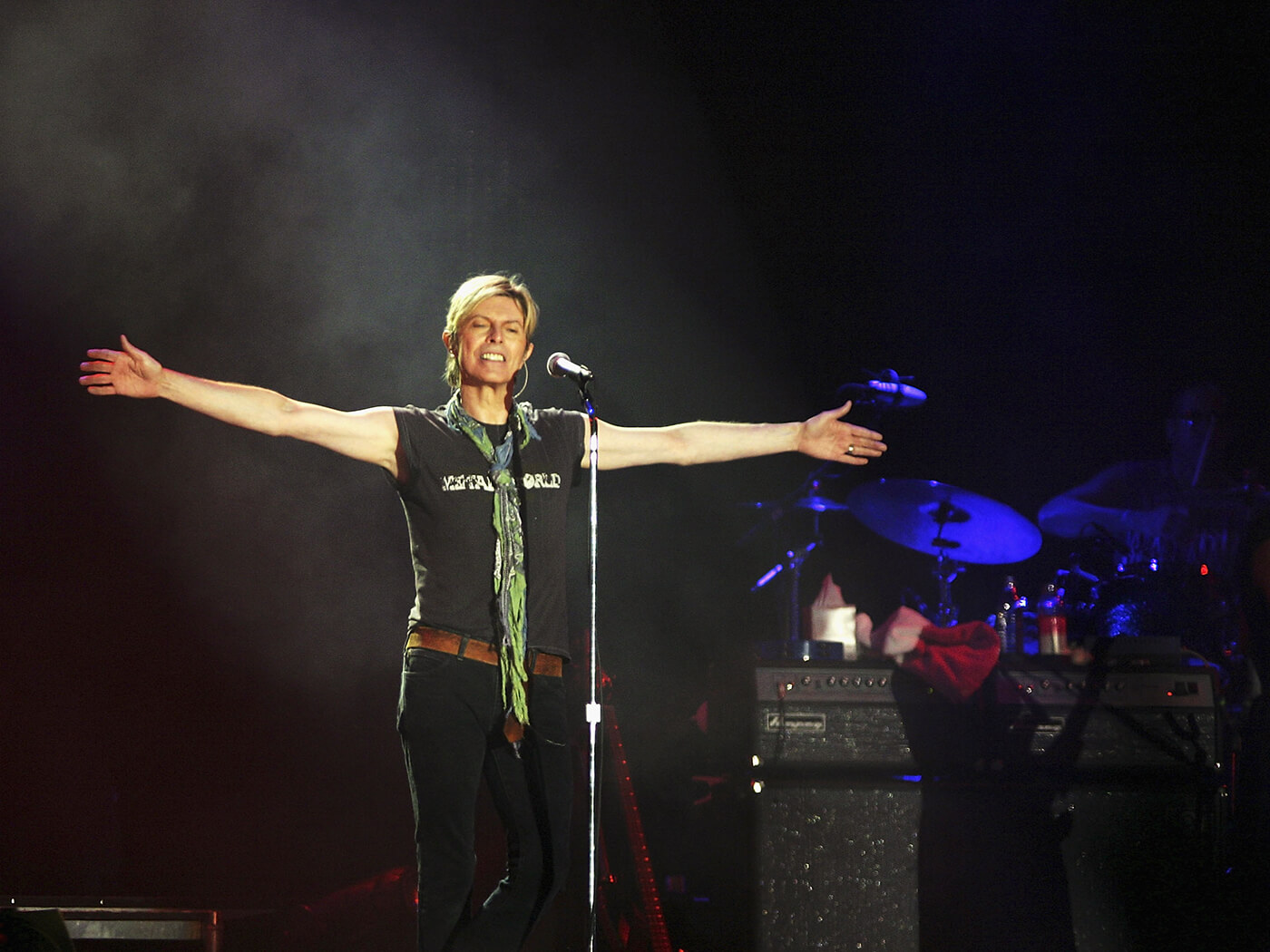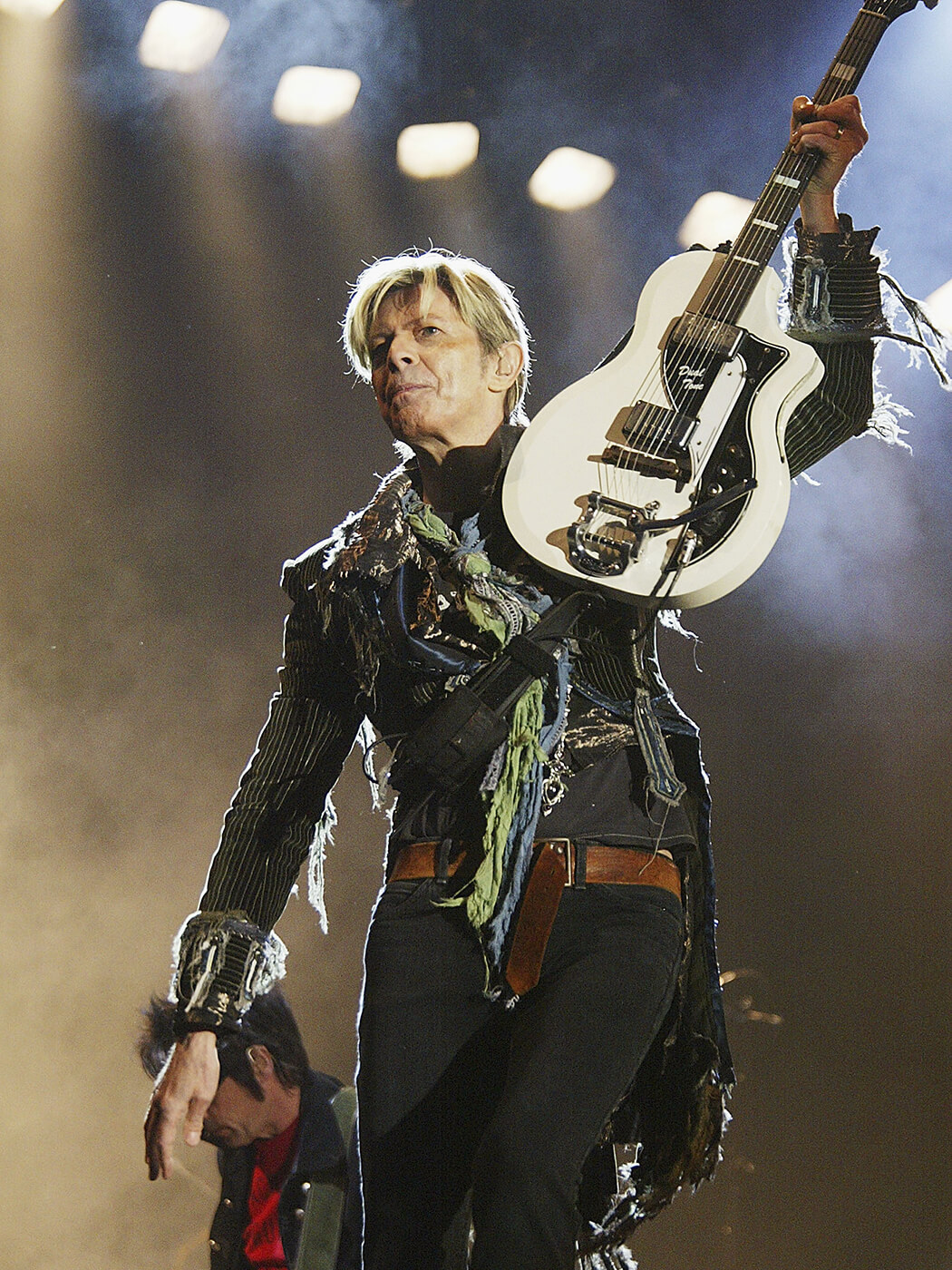The Genius Of… The Next Day by David Bowie
Heralding the return of one of music’s most potent creative forces, The Next Day granted David Bowie’s guitarists a vast field on which to build vivid colours of powerful and serene guitar.

Image: Dave Hogan / Getty Images
In decades past, a level of detached mystery – and the ability to craft an entirely original, modern mythology – was central to the appeal of many of pop’s biggest figures. For David Bowie, the Mount Olympian influence that celebrity granted would be an ongoing fascination throughout his career. Exploring this dynamic, Bowie clad himself in the garb of superhuman, semi-magical figures such as glam rock titan Ziggy Stardust, and the enigmatic Thin White Duke, revelling in the many layers of artifice a pop star could wrap themselves in, while also being gifted with the ability to generate era-defining, life-changing records.
After nearly 40 years of astounding creative and commercial success, Bowie showed few signs of slowing. With 2002’s compelling Heathen rapidly followed up by 2003’s exuberant Reality, Bowie seemed to be as creatively inflamed as he was during the making of his matchless 1970’s run of records. In 2004 however, during the globe-spanning A Reality Tour, a terrifying heart scare at the culmination of a show at Germany’s Hurricane Festival cut short the tour’s originally intended run time, and marked (what many thought would be) the end of the 57-year-old Bowie’s professional career, as he stepped back into the shadows.
For the rest of the 2000s, the New York-based Bowie was rarely seen, bar a few fleeting appearances to signal his endorsement of the latest crop of cultural movers and shakers (notably, with Arcade Fire, at Fashion Rocks in 2005, and with Ricky Gervais, performing the hilarious Pug Nosed Face on Extras) But, for his worldwide congregation of devotees, the promise of serious new music – an ever-present thread that had been running since Bowie’s debut in 1967 – wasn’t forthcoming.
Where are we now?
It wasn’t long before Bowie’s band resigned themselves to the realisation that their figurehead had quietly retired either. As the years passed, Gerry Leonard, Bowie’s mainstay guitarist and band leader since Heathen, was enjoying a varied career as both a touring guitarist and musical director for Suzanne Vega and Rufus Wainwright, as well as composing soundtracks for film and theatre. It came as something of a bolt out of the blue when an email from Bowie suddenly appeared in Leonard’s inbox, asking if he was free to work on some new material. Though he was keen to reunite with his former boss, Bowie insisted that he, and the other musicians on the record, would have to ‘keep schtum’ during the recording process.
Gerry Leonard explains to us that whenever he worked with David, there was an attitude of ‘bring your junk’ in guitar and tech terms, though there was the caveat that space was going to be minimal. “We knew we wanted to track live and so we needed isolation,” Leonard explains. “But the space was tight as always in NYC. I ended up using two Mesa/Boogie 1×10 speaker cabs powered by my amps of choice (Mesa TA-15 and Sommatone Roaring 40 mostly), I had my usual live guitar rig (a smaller tour rig) with a switching system which allowed me to set up the songs like a live show with snapshots for each section.”
Across the recording process, Leonard mainly stuck to a trusty triumvirate of Gibsons. “I used my ’69 Gibson SG, my ’65 Gibson Firebird with P-90s and a custom Les Paul with Bigsby,” details Gerry. “My effects rig was really a combination of things: TC Electronics G Force, Electro-Harmonix POG and Big Muff, Tube Screamer and also some Lovetone pedals – the Big Cheese and Doppelganger. One piece I rarely use but brought out for the record was the EMS Synthi Hi-Fli. That thing is super rare and has such a killer vibe. I had it patched on and used the vibrato, filters and fuzz quite a lot.”
Meeting up with Bowie’s longtime producer Tony Visconti and drummer Sterling Campbell, the team set to the task of getting the new tracks worked up. “Sterling Campbell was on drums, I was on bass, David was on keyboards, Gerry Leonard was on guitar,” Visconti told The Telegraph. “By the end of five days we had demoed up a dozen songs. Just structures. No lyrics, no melodies and all working titles. This is how everything begins with him. Then he took them home and we didn’t hear another thing from him for four months.”
At the conclusion of the writing sessions, recording began at The Magic Shop and Human Worldwide Studios, with Bowie’s bass alumni Gail Ann Dorsey returning to helm the low end, and rhythmic heavyweight Zachary Alford heading behind the kit. Wishing to avoid press intrusion, label pressure or indeed the crippling weight of audience expectation, Bowie was keen to keep everything pertaining to The Next Day (and his personal life) tightly under wraps.
“I’ve owned this studio for 26 years, but I’ve never experienced the level of secrecy we had to achieve for David’s album,” said Steve Rosenthal, the owner of New York’s The Magic Shop in an interview with LouderSound. “Each time David came to the studio we allowed about 60 per cent of our staff to take time off, because the more people who knew, the more danger there was of the story getting out.”

Dancing out in space
With his tight gang of loyal musicians firmly in place, the record’s diverse array of sounds began to find shape. Spanning the melancholic, wispy nostalgia of the shimmering Where Are We Now?, the frenetic raw spike of the title track, the soaring lead riffs of the eastern-sounding I’d Rather Be High and the Motown-meets-garage rock thrust of The Stars (Are Out Tonight), quality cuts were in rich supply.
“The songs all went down pretty fast,” Gerry Leonard recalls. “We had made very rough demos. I had charted those out and we just really went and played them a few times. David liked to work quickly so it was generally done in two to three takes. We made some changes on the fly and a few quick overdubs but they were mostly tracked live – no pressure!”
Propelled by Dorsey’s danceable bass-line, The Stars (Are Out Tonight)’s verse chords oscillated between and F♯ minor and a D major, with Leonard augmenting the sound with a series of figures that bring out and suggest certain melodies, triggering high E notes to imply a more nuanced key. “I thought, if we’re going to be playing this for a long time, it might be good to have development in it… have two or three different parts I could overlay over the same chords and hopefully find a way to be part of the dynamic of the song, kind of sculpt it a little bit,” Leonard explained during a workshop at Xmusic in Dublin.
While Leonard was the central spine from a guitar perspective, the additional colouration of guitar-soundscape crafter David Torn helped to shade the mixes. “I think DB picked us for what we do,” Leonard tells us. “I tracked sometimes with David Torn and that’s always a trip. Torn is a wizard but listens well and finds his space. I have immense respect for him as a guitar player so would always try to find complementary parts.”
Torn’s contributions notably bolstered the mix of Stars… as well as the pulsing undercurrents of the Earthling recalling If You Can See Me and the humming throb of the record’s downcast closer Heat.

Set the world on fire
The third segment of the guitar ensemble came in the form of the respected rock chops of Bowie’s long-serving compatriot Earl Slick. Toting his signature P-90 equipped Framus, as well as a hollowbody Framus Mayfield, Slick brought some raw energy to the table. “The tracks were all in different stages,” Slick told MusicRadar. “As a matter of fact, we cut three new ones with me, Sterling, David and Tony Visconti on bass. I overdubbed maybe another five tracks that were already done but needed guitar. They had Gerry’s atmospheric stuff, but they needed some of my crunch. So that’s what I did, all of it in five or six days.”
Key tracks that were suitably beefed up by Slick’s presence include the sleazy grind of Dirty Boys, the monolithic power chords of You Will Set The World On Fire and album highlight Valentine’s Day. Intending to replicate the sound of a fumbling amateur high-school band, rehearsing in their garage. Valentine’s Day’s shabby retro acoustic chord sequence of D, Bm, F♯m and A was coated in gnarly, muddy riffs, intentionally performed by Slick with a studied sloppiness to evoke a starry-eyed innocence, cut short by the titular character of Valentine, a vengeful high-school shooter. The sublime composition was among Bowie’s most pointed political statements on record, decrying the horrors of gun violence in American society. (This was underlined further by its NRA-baiting video, in which Bowie emulated Charlton Heston’s infamous ‘from my cold, dead hands’ rifle raise.)
Taking no prisoners musically or professionally, Slick’s deranged solo at the culmination of (You Will) Set the World on Fire led to a heated moment. “The engineer was having some difficulties with me and vice-versa,” Slick told The Herald. “I was trying to get the solo and it just wasn’t coming to me. David gets on the intercom and he’s pissed off with what’s going on. I blew a gasket, I said: ‘Look if everybody leaves me alone – including you, this is a one-take deal!’ It’ll be done and you’ll be home in time for dinner’. He just threw his hands up in the air and sat down. I said ‘roll the tape’ and after one take, David pops up like a puppet and says, ‘that was great!’.”

If you can see me
In the era of an over-saturated PR and an always-on social media landscape, true surprises are scarce, but the morning of 8 January 2013 stunned all. Masterfully calculated to have no preceding fanfare, Bowie dropped a brand new single, Where Are We Now?, and with it, the promise of his first new album in the years – The Next Day – coming in a mere three months.
Carrying no less than the weight of a returning musical deity, not to mention its compelling anti-hype PR approach (with no interviews to promote an album that nobody knew he was making), expectations were stratospheric. Astonishing then, that The Next Day delivered on the promise. The album’s skilfully assembled songs astonished all who listened.
“David Bowie has made a career of walking that line between the picture people want to see and the one he wants to give them,” wrote Pitchfork. “In this way, The Next Day finds him as astute as ever, casting a ghoulish shadow over sounds and images we know and love.”
Meanwhile, NME highlighted the intense work that had gone into the construction of the record’s 14 tracks: “This album is, foremost, about songcraft. Rather than reinventing Bowie, it absorbs his past and moves it on, hungry for more.”
Looking back on a writing process that began ten years ago, Leonard still recalls the sessions fondly: “There were so many good moments for me, aside from the main guitars on (Bowie/Leonard co-writes) Boss of Me and I’ll Take You There. I like the signature riff on The Stars (Are Out Tonight), my nod to Peter Green on Love is Lost and the ambient wash on Where Are We Now? All of these parts came pretty quickly when we worked on the demos and they held up for the recording days.”
Heartbreakingly, three years after this astonishing return, the extraordinary life of David Bowie would come to an end, shortly after the release of his final LP, Blackstar. Though The Next Day can be read as the work of an artist drawing together the strands of a musically diverse career, Bowie’s cunning rejection of the modern hype-train of the industry, and his decision to cloud himself and the album’s genesis in a cloak of mystery proved that, even at this late stage, Bowie was still able to navigate the cultural zeitgeist in his own, ingenious way.
All that aside, The Next Day holds its own simply as a damn fine guitar rock record – and is arguably among the punchiest in Bowie’s entire canon. The alchemy of Leonard’s immaculate chord structures, Slick’s fiery rock energy and Torn’s textural undercurrents accentuates Bowie’s writing and vocal performances, forging not just a breathtaking comeback, but one of David Bowie’s greatest ever albums.
Infobox
David Bowie, The Next Day (ISO, Columbia, 2013)
Credits
- David Bowie – Vocals, Acoustic Guitar, Guitar, Keys, Production
- Gerry Leonard – Guitars
- Earl Slick – Guitars
- David Torn – Guitars
- Gail Ann Dorsey – Bass
- Zachary Alford – Drums
- Sterling Campbell – Drums
- Tony Visconti – Engineering, Mixing, Production, Guitar/Bass
Standout Guitar Moment
Valentine’s Day
For more reviews, click here.
